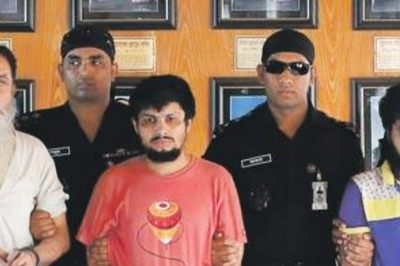
views
New Delhi: The Central Reserve Police Force convoy that came under attack from a Jaish-e-Mohammad suicide bomber in Pulwama killing 40 soldiers consisted of buses "with thin metallic plates which offer no protection from bullets or IED”, said a CRPF report while adding that protection at "vulnerable places" is provided by the Army.
The demand for an armoured convoy and “better support” from the Centre has persisted for years – but to little avail and as the death toll rose on Friday, many argued that air lifting the forces could’ve prevented the loss of life.
While the convoys – from Jammu to Srinagar and vice versa – run smoothly during summers, they are “not regular during winters and rainy season because of snowfall and landslide” and consequently personnel of up to three to four thousand get stranded at Jammu’s transit camp on a regular basis. “The transit camp has limited capacity to accommodate thousand personnel at a time (and) beyond that personnel are shifted to nearby location,” says the report.
“Up convoy (from Jammu to Srinagar) plied only three days in the past 15 days because of heavy snowfall. The Last up convoy on (February 4) in which 91 vehicles with 2871 transient (forces) moved from Jammu to Srinagar,” said the report.
By July 2018, faced with a “tedious” procurement process, the CRPF had taken matters into their own hands and attempted to armour plate the many vehicles and troop carriers it had through “improvisation” – sourcing locally available metal sheets, concrete and wooden planks to create a make-shift aegis.
"We are trying to acquire more bullet-proof vehicles (for deployment in Kashmir). Since, the rate of procurement and procurement through suppliers is a tedious process...we decided to improvise," CRPF Director General RR Bhatnagar had told reporters on the eve of the 78th Raising Day of the paramilitary force.
The improvisation was described as a “short term measure”, with the force trying to “partially bullet proof” their buses – at the time.
Non-traditional attack caught forces off guard
A key facet in the report is that while the “traditional” threat to convoys has been in the form of IEDs and bullets – the use of a suicide bomber in a bomb-laden vehicle took the forces off guard.
“The threat to convoy in the valley has always been from standoff firing and IED planted conventionally for which adequate security measures have been devised and implemented. Troops too have been trained and sensitised for the same,” says the report.
“But probably this is the first instance where a suicide bomber in an explosive-laden vehicle has triggered the blast inflicting huge casualties,” admits the report, while adding, “In the instant case it appears that the militants entered the highway from the link road from (Kakapora to Lelhar side) and was moving on the left side the moment CRPF bus was on its right triggered the explosives-laden vehicle.”
“The ROP for the movement from Jammu to Srinagar is provided by CRPF and Army. Corridor protection is also provided by Army at vulnerable places,” it adds, while pointing out that civil traffic movement is kept open during convoy movement.
“Civil vehicles are not stopped while convoy passes any stretch and are even allowed to overtake and come in between security forces vehicles, if required,” says the report, while adding that upon reaching Quazikund additional vehicles are attached with the convoy to prevent firing or ambush attempts – methods that have been historically the “main threat in the region”, and only after ROP parties give the clearance that there aren’t any IEDs, do the convoys proceed.
Former CRPF DG Durga Prasad explains, “Even if someone fires a weapon, loss of life is minimized in the case of an armoured convoy. But if you see the type of situation, we are seeing right now – when a vehicle rams into yours, it is different.”
Adding that it was impossible to have someone man every junction, entry and exit point at the highway, he said that “airlifting troops” would have been ideal and could have prevented the loss of life.
The former DG isn’t the only one to ask why the CRPF were asked to travel in a convoy. After former CM Mehbooba Mufti posed the same question, the state's ex-top cop said that he had proposed to airlift soldiers to avoid Pulwama-like tragedies. He told News18, "The transit alone takes a lot of time, especially when the roads are closed for weeks. This exposes the soldiers for a prolonged duration. I had proposed to airlift the jawans during high-level security meeting of joint forces more than once, and also to representatives of state and Union governments."
The primary opposition to such an idea, he realised, would be the costs involved. But, Vaid said, in his presentations he had shown, based on his calculations, that the cost difference in airlifting soldiers to and from Kashmir was “comparable” to the costs involved in bringing in and out of the valley by road.




















Comments
0 comment